NOTE: There’s a two-hour webinar training available on performing in schools where we cover what schools want, how to put a show together, pricing, marketing and more. The video is available for purchase at the Performing in Schools: How to Create and Book Your Show page.
I’ll never forget my first performance for a group of school kids.
It was January 1995, and at the time I was what you would call a “gigging musician.”
My normal routine back then involved rolling out of bed sometime between 9am and Noon (depending on how late the night before had been), perhaps teaching a few guitar students during the day, and then playing out that night in a bar where the band might start at 11pm.
Or 11:30pm.
(Famously, the bars in Buffalo NY where I live stay open until 4am, so everything tends to start a bit later…)
 I had received a call from a musician friend who said “hey, we’ve got this trio that goes into schools doing Erie Canal music (what?) and we just lost our third member. Do you want to do a few gigs with us?”
I had received a call from a musician friend who said “hey, we’ve got this trio that goes into schools doing Erie Canal music (what?) and we just lost our third member. Do you want to do a few gigs with us?”
Needless to say, I had no idea what Erie Canal music was, and even less of a clue about performing in schools, for kids.
Me: “Um…sure. What time’s the gig?”
Him: “8:30am. You’ll be home by 10.”
Me: (long pause…..)
Did he say 8:30am, as in 8:30 in the morning?
How That First School Gig Went
So I boned up on the material quick – – there were about seven songs to learn, and some speaking lines too.
(What? I need to actually say things to the audience?)
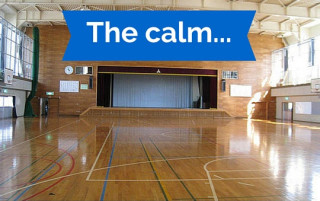 We arrived at about 7:30am and loaded into that brightly-lit Catholic School gymatorium, and I just had no idea what was about to happen.
We arrived at about 7:30am and loaded into that brightly-lit Catholic School gymatorium, and I just had no idea what was about to happen.
We set up the PA system, rehearsed a few things, I took some time to go over my speaking parts in my head.
And then, the kids – – all 250 of them – – began filing in to that large, boomy, uninviting room.
Big kids, little kids, LOUD kids.
I think it must have been every grade level from Kindergarten to 8th. Quite a span of ages.
They took their seats on the floor in a somewhat orderly fashion as the principal made her way to the stage to greet us and, ultimately, introduce the show.
Off we went….
That first show was definitely a blur. The songs were new to me, the comedy and schtick and scripted nature of the show were completely foreign, and I learned a whole lot real quick about how NOT to talk to a room full of kids.
But when I came out on the other side of that performance, I was left with a very definite feeling.
I LOVED IT. I absolutely loved it.
 The kids had so much fun. They were wide open and eager for more. They laughed. They moved on cue. They might have even learned something!
The kids had so much fun. They were wide open and eager for more. They laughed. They moved on cue. They might have even learned something!
And the best part?
They didn’t need a single beer before they warmed up to us.
I pretty much decided then and there that I wanted to be doing a whole lot more of this, and because of some issues I’d been experiencing with tendonitis, it was also a very logical career move to start pursuing 45-minute gigs that pay really well and don’t involve tearing my arm apart from overplaying.
So here’s what I did…
It’s pretty amazing to think about what a turning point that gig was for me.
From that moment forward, I made it my goal to figure out how to work in schools as much as possible.
I’ve spent twenty-six years (and counting…) doing exactly that.
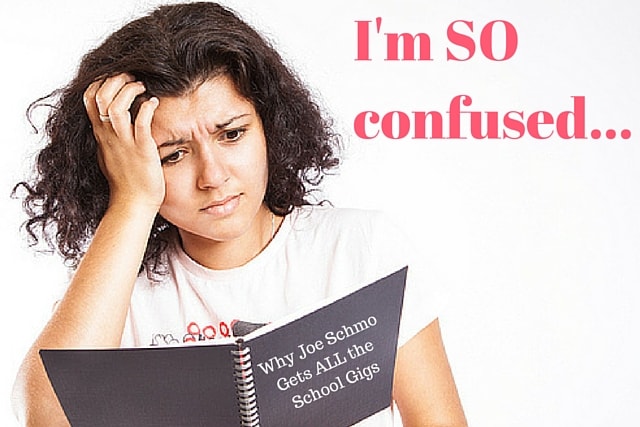 The hours are hard to beat, the work feels really meaningful, and I’ve been able to make a great living doing it.
The hours are hard to beat, the work feels really meaningful, and I’ve been able to make a great living doing it.
I hope that some of what I’ve learned along the way will be helpful to you.
(You might also be interested in the article “How to Get Gigs in Libraries.”)
How to Work a LITTLE in Schools
Do what you do and spread the word
I think there’s room for just about every performer in every genre to get the occasional school gig without really changing much of anything about what you do.
Sometimes you’ll find a music teacher, for instance, or an administrator, who feels strongly about providing students with cultural experiences outside of the mandated school curriculum.
There are plenty of educators who believe in this approach, and of course, all the research backs up the importance of the arts to a well-rounded and sane society (to say nothing of all the academic benefits of an arts-rich curriculum).
The problem is that it’s becoming ever more difficult for schools to justify losing the sacred instruction time each teacher needs in order to get through their curriculum and prepare students for the multitude of tests and assessments they’re faced with.
Sadly, the days of “art for art’s sake” seem to be mostly behind us in K-12 education, at least for now.
However, that shouldn’t stop you from making connections with the appropriate people within your regional schools and letting them know about what you do.
They may have an event or a “tie-in” that you weren’t even aware of that makes you the perfect fit for a booking.
 If there’s any kind of label or authentic category you can put on what you do, you might consider adding that to your materials. It will give schools (and libraries, and other venues) something to “latch onto” when considering you for a booking. For instance, if you’re a string quartet, could you call yourselves an “American String Quartet,” or a “Pan-European String Quartet?” Maybe the school will be having an “Americana Day” or an “International Festival” in the coming months…
If there’s any kind of label or authentic category you can put on what you do, you might consider adding that to your materials. It will give schools (and libraries, and other venues) something to “latch onto” when considering you for a booking. For instance, if you’re a string quartet, could you call yourselves an “American String Quartet,” or a “Pan-European String Quartet?” Maybe the school will be having an “Americana Day” or an “International Festival” in the coming months…
How to Work a BIT MORE in Schools
Do you already perform for kids?
If you’re somebody who already provides fun and engaging performances for kids outside of educational settings, there is definitely still room for you in the schools.
Whether you’re a juggler, storyteller, musician, dancer, or three-wheeled-unicyclist, your show might be perfect for one or more of the following school events:
- Fun Day
- End of the Year Picnic
- Friday afternoon before school breaks
- Evening Family Events
- Celebrations for a job well done (Reading incentive programs, etc.)
For these occasions, the school may be looking for something “fun” with no specific educational theme. Your contact person for these kinds of gigs could be any number of different people – principal, PTA/PTO/Parent Organization, one specific teacher who’s in charge of the event, etc.
Best to ask.
How to Work EVEN MORE in Schools
It’s not about you, it’s about them!
The more time I spent in schools, the more I began to notice what it was that they were interested in.
On my way from the auditorium stage to the main office or the loading dock, I’d see signs on the wall that looked like some of these:
- Character Education
- Healthy Eating
- Reading
There are school-wide initiatives that most schools take on every year, and these can last from a few weeks (reading incentive programs) to a month (diversity or multicultural month) to an entire school year (character education, healthy choices, drug-free living, etc).

The Hill Brothers back in “the day”
Remember the performing group I mentioned at the beginning of the article?
Well, they’re still around. They’re called The Hill Brothers, and over my twelve-year tenure with them, we wrote several new shows to address some of these themes head-on.
It was actually a blast trying to figure out how to make these topics interesting, humorous, fun and musical for kids, and in the process, our bookings went through the roof!
The group did over 300 shows during one very memorable (and tiring) school year alone.
The demand for such programs has trailed off perhaps a bit since then, from what I can tell (I have moved into other subject areas myself.)
However, artists who have created programs around these topics are still getting booked regularly.
Why?
Because they’re offering something that speaks directly to the needs of the school.
How to Work a LOT in Schools (this is what I do most…)
Integrate with the grade-level curriculum
I surveyed 700 elementary school educators a few years back about the role of the arts in their classroom teaching.
Granted, these were 700 teachers who had registered their classes for a live online concert I was giving, so perhaps they were predisposed to warm feelings for the arts.
Still, their answers were really interesting.
Q1: Do the arts help make learning fun and relevant for your students?
- Yes – 96%
- No – 3%
- Not Sure – 1%
Q2: Would you like to be using more music in your teaching?
- Yes – 92%
- No – 8%
OK, so far so good! This is very promising.
But now, here’s the big one…
Q3: What’s the #1 thing keeping you from using more arts in your teaching?
The choices were “Budget,” “Time,” “Not Sure How To,” and “Don’t Care To.”
What do you think they said?
517 of those 700 teachers (a whopping 74%) gave the same answer:
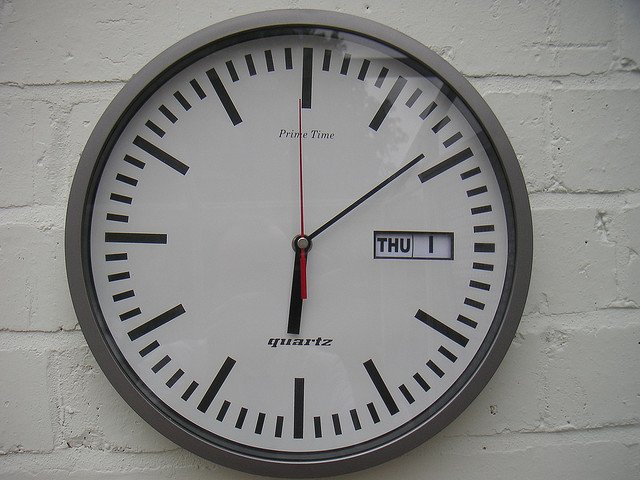 Lack of time is the #1 thing keeping educators from using more arts in their teaching.
Lack of time is the #1 thing keeping educators from using more arts in their teaching.
The reality of teaching today
As mentioned earlier, educators are under a tremendous amount of pressure right now, and have been for some time.
In fact, I can’t tell you how many teachers have told me they’re warning their own college-aged children to go into any field except education.
By and large, educators are pro-arts and would love for their students to be getting more. They understand not only the intrinsic value, but also what the arts do for student engagement, motivation, and processing of information.
They just can’t give up the instructional time.
So what do we do?
Here’s what we do:
We create performances, workshops, and/or programs that dovetail directly with things they’re already teaching in the classroom.
This is it.
This is what’s enabled me to keep my calendar filled to capacity with really satisfying school bookings each year.
Offer the schools something so valuable to their teaching that they will go out of their way to make it happen.
 Here’s an example
Here’s an example
I’ve always been interested in history and culture. I’m also a musician.
Through my experiences doing Erie Canal music in schools with The Hill Brothers, I learned that 4th grade is the year that all New York State students study local and state history.
Great! What else do they learn about besides the Erie Canal?
By talking to some teacher friends, I was able to get a copy of the old “Scope and Sequence” curriculum guidelines that schools were following back in the late 1990’s.
A big old xerox of the entire thing.
In that document, I could see exactly what social studies and history topics were being covered at each grade level from K-12, and within each unit of study, I could drill down to discover exactly what content the students were charged with learning.
Here’s an excerpt from the modern-day equivalent of that document, now available online as New York State K-12 Social Studies Framework, from the 4th grade section:
 What we can see very clearly here is that in fourth grade, one of the first units the teachers will cover in the fall (4.2) is on the Native Americans who inhabited the area before European contact.
What we can see very clearly here is that in fourth grade, one of the first units the teachers will cover in the fall (4.2) is on the Native Americans who inhabited the area before European contact.
Ding ding ding! I’m really interested in Native American history.
This is where my first curriculum-related program was born. It was going to be just for 4th graders, and filled with interactive music and history to illuminate Haudenosaunee life.
I called the show “The Native Americans of New York State,” which is how the unit was titled in the old curriculum guide.
 To whatever extent possible, use the exact same language that educators use when you title and describe your program. Since the teachers refer to this unit as “The Native Americans of New York State,” I called my program the very same thing, word for word.
To whatever extent possible, use the exact same language that educators use when you title and describe your program. Since the teachers refer to this unit as “The Native Americans of New York State,” I called my program the very same thing, word for word.
I had a great time investigating traditional Iroquois (Haudenosaunee) music from old ethnographic field recordings, contemporary Iroquois singers and other materials, and boned up on as much Haudenosaunee history as I could specifically as it related to the aspects of Iroquois life students would be learning about in 4th grade. (4.2a, 4.2b, 4.2c above.)
Once I got my feet wet, I added a songwriting component as well.
Here’s a section of the original postcard I was sending out to 4th grade teachers to market the program. Notice how the whole thing speaks directly to the teachers, and the last line assures them of its relevance to their work:
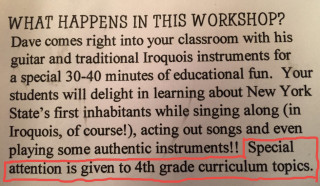 Still today when I describe the program on my website, I use the following words (which might look really familiar from section 4.2a in the curriculum document above):
Still today when I describe the program on my website, I use the following words (which might look really familiar from section 4.2a in the curriculum document above):
“Topics covered include the Iroquois’ use of their surroundings to meet their basic needs for food, clothing and shelter, and the forced relocation of the Iroquois to the reservations.”
Can you see how irresistible a program like this would be for a teacher? Now they have someone who can come into their classroom (or auditorium, or gymnasium…) with an arts-based learning experience tied directly to what they’re teaching.
Their curriculum + your artform + active participation + rich content + humor + fun = the very best kind of learning experience.
Teachers know this, and they’re willing to find the resources to make it happen. (You can help with that too, but that’s for another blog post.)
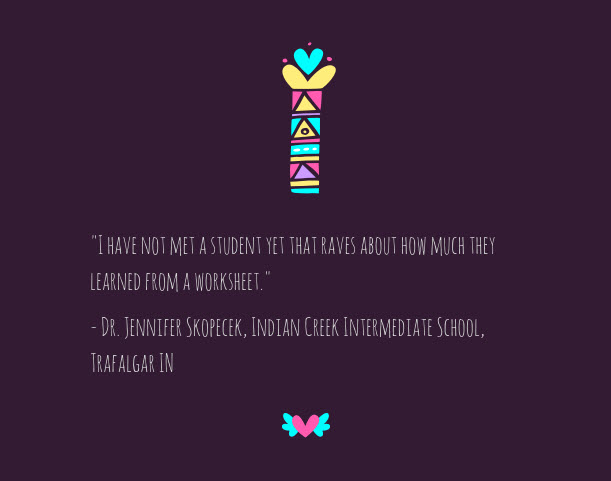 Are You Ready?
Are You Ready?
I hope this has given you lots of food for thought. I’m going to leave you with a few ideas to pursue if you so choose.
Whether you already perform within a certain genre (French Canadian music, African drumming, Aboriginal storytelling, Russian dance, etc), or you’re wide open to inspiration in terms of topics, here’s what I would do:
- Perform an internet search for “(Your state) Social Studies curriculum by grade level,” or “(Your state) English Language Arts curriculum by grade level.” Other categories to try would include “Math,” “Science,” and “Languages other than English.”
- Find some topics in those listings that you are already passionate about and/or have some expertise in.
- Spend some time putting a well-researched and thoughtful presentation together. Try it out in a few schools, refine the program with teacher feedback, get some authentic quotes from those teachers who’ve seen the program, and then let every teacher at that grade level in the entire state know about it.
You’ll be in business in a big way.
If you need any final inspiration…
Consider this: my chosen content area (history/social studies) has been the least emphasized, the least tested, and therefore the least important of the major curriculum areas in American schools for about fifteen years now, as No Child Left Behind, the STEM movement and Common Core have successively shifted the focus towards math, science, technology and english language arts.
My work is in an area that could easily be considered the poor little step-cousin of the other subjects right now. Social studies content has even been folded into English Language Arts lessons of late.
And yet, I can’t keep up with the demand for my programs.
Why is that?
I think it speaks volumes about this approach: make yourself so valuable to the schools that they can’t help but want to have you.
I’d love your comments below.
About The Blog
 Since leaving a white-collar marketing job in 1992, Dave Ruch has been educating and entertaining full-time in schools, historical societies and museums, folk music and concert venues, libraries, and online via distance learning programs.
Since leaving a white-collar marketing job in 1992, Dave Ruch has been educating and entertaining full-time in schools, historical societies and museums, folk music and concert venues, libraries, and online via distance learning programs.
Along the way, he’s learned a great deal about supporting a family of four as a musician.
The Educate and Entertain blog provides articles, tips, encouragements, and how-to’s for regional performers (in any region) interested in making a great full-time living in the arts.


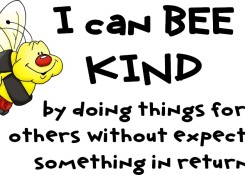

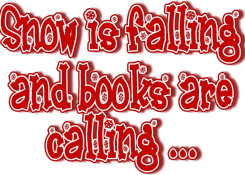
I’m a musician who has a music booking company.
I’m in the process of starting to figure out how to bring bands into schools
This looks like a great resource
Thank you!
I’m so glad I found your site! My daughter , who has a wildlife biology degree, and I want to create a program to educate kids about wildlife. She has visited my classroom as a favor to me and the kids were so engaged. She created a kit with feathers, bones and other items kids can touch and handle. Once we create a program, How do we get paid through the Boces coser when we’re booked at a school? Is that work done on our end? Any information is appreciated!
Hi Loreen – glad you found your way here. It sounds like you’re in New York State, so the BOCES CoSer works a bit differently depending on what part of the state you’re in. In general, once the booking is made, the school would contact their BOCES arts in education department and BOCES would start the paperwork process. From there, you would hear from BOCES with their exact procedure for getting paid. This generally either involves filling out and signing their paperwork ahead of time, or issuing them an invoice after the performance, or a combination of the two.
Thanks Dave,
Thanks for writing this.
I am a facility manaager for a large elementary school in WA state. We are considering putting on a bluegrass show with an internationally known band. I am so naive in terms of what I need to make this happen from a sound standpoint. Is a soundboard required? Do I need more than a PA?
That would be a question for the band you are bringing in, as they will surely know best what they’ll need in terms of sound reinforcement.
I’m excited to find out there are people out there with your experience, knowledge and my interests. I am trying to launch (pun intended) a program presenting the mission of Apollo 11 and how they landed a man on the moon. I have researched and completed a Powerpoint program which includes videos, photos and explanations. I have a desire to display the courage, perseverance and patriotism of the Apollo mission. I just began my endeavor and want to learn how to introduce my program and get invitations to any organizations who are interested. Thank you.
Glad you found your way here, Eric. There are dozens of articles on the blog to help you get bookings for educational entertainment programs.
What a great blog, a really valuable read, Thank you. I’ve been delivering history workshops & presentations in schools full time for over 25 years in the UK and have now moved to Canada to semi-retire, doing the same thing. You’ve encapsulated the techniques for getting the work in so well. I’ve yet to follow up some of the links you’ve made, but do you know of any booking agents who might be interested in putting a tour together in a couple of US states?
Hi Kevin – I hope you will share your experiences here on the blog as time allows. You would have lots of valuable info to contribute on doing this work, As for booking agents, I don’t. I’ve always booked myself. You could certainly see about getting on the artist roster with Young Audiences, but you’d need to choose one or more of their regional chapters based on where you might want to perform.
Thanks Dave, I’ve always booked myself too (or at least my wife has ;-).
I’ll certainly check out Young Audiences as I’d like to travel a bit periodically, around Canada and the US, and a small ‘tour’ of specific region would help fund that.
I’ll keep in mind sharing on your blog. All the best – Kevin
Hi Dave, I am a 72 year young woman who used to entertain children by being “Chuchu the Doll who comes to Life”. But now I am trying to go to senior facilities. Boy, seniors are a ruff crowd,
I had my first performance yesterday at an over 55 facility. When I was done one senior responded to me, while making a sour face, “We seniors need to be entertained!” Well, I thought I did. I put money, and time into this five page, live doll act. So, do you have any suggestions as to how I can make it “Entertaining” for them?
Hi Sharlene – sounds like you haven’t seen Allen Hopkins’ article on performing for seniors. I don’t do that kind of work myself, but he wrote a very comprehensive article about it which you can find at this link.
I’m a performing artist working with an AIE program and i stumbled across your site. I cant tell you how motivational and helpful it is, This is the virtual kick in the pants I needed to promote myself more. Great post, thank you for sharing.
Welcome, Dan. Really glad to hear that. I hope you will post often and share your experiences.
Hi Dave, so glad to find your helpful website. Would you tell me how long your typical school performance is? What do you think is the best length that works for schools based on your experience? Also how long is the typical school assembly performance?
Thank you for your help.
Hi Akemi – I think 45-60 minutes is perfect for a school performance; possibly a bit shorter (30-40 min) for really young Preschoolers and Kindergarten.
Great, thank you very much!
Hello Dave
My husband and I are an Americana/Folk Singer Songwriter Duo from Florida and my husband is from a 7 th generation Florida Pioneer family that he has written many songs about . We have wanted to get into schools at this point we do festivals , house concerts , restaurant and such. We do get chikdren up and participating when they are present. Could you give me a few tios on how we should start to get into the school system
HI Zetha – this sounds like a natural fit to me. If I were you, I’d do a search online for “Florida Schools Curriculum by Grade Level.” From there, find the grades that learn state history (there’s probably one grade in elementary schools & one in middle schools and possibly one in high schools) and start reaching out to those teachers to let them know about what you do. As mentioned in the article above, the closer you can tailor your program to the actual standards and curriculum the teachers need to teach, the more work you will get.
If/when you want to take it further, the webinar on creating and booking school shows is packed full of best practices. You can click here for more info.
Dave, thank you for this helpful blog post. My husband is a singer / songwriter. He’s been writing music for 30 years. we have a large family, 8 kids., been married 25 years. He also has Cerebral Palsy. He recently started sharing his music monthly locally to about 40 people per gig. Someone suggested that he look into going to the schools and sharing since he is a special needs dad. They say that lots of parents of special needs kids would be encouraged by his story and music. I looked up local private schools, what would you suggest I do to contact them? Email someone, or send a letter in the mail? Any other tips would be most helpful. Thanks!
Hi Erin – I think this would be great. Email seems to work well for schools, but letters might also be effective. Typically you can get the main office on the phone as well, though it might be harder to connect with a teacher or decision maker. Explaining things to the secretary in the main office should get you results though, since you have such a unique offering. Good luck with it, and please keep us posted.
Thank you for your quick reply! Yes, I will keep you posted.
Just stumbled across this blog and it’s so wonderful! I’m currently an elementary school teacher but have an undergrad degree in theatre and still perform and direct children’s theatre in the summers. I’m thinking about leaving full time teaching to pursue something more like you! I love finding creative ways to connect with the curriculum and include music or theatre into my daily classroom routine, but unfortunately it often gets pushed aside because of all the other demands and time restraints I have on a day to day basis. I think doing school assemblies could be a great way for me to still connect and work with kids, but be more creative and actually have time to pursue more artistic and creative endeavors. I still haven’t made my final decision yet if I’m going to leave or not, but it is encouraging to know that it is possible to make a living doing something like this if you are willing to put in the time and effort.
I will be looking at many of these articles in the next few weeks! Thanks for putting all this information out there, it’s extremely helpful and informative! I really appreciate it!
Also, can you recommend a good post or thread to start off with more of the basics of getting started with something like this? I think the business/marketing side of things will be my biggest challenge since I have no experience with that sort of thing. As a teacher, the working with kids part is the least scary for me!
Hey Lauren – great to hear from you. I’m happy to know that you’re finding useful stuff here, and you are echoing what I hear all the time from teachers about time constraints and the inability to get creative with their teaching. There is a huge void out there right now – and we are the ones to fill it!
Posts to help you with the marketing side of things can be found HERE and also HERE
Also, there are two video trainings available for purchase that might be right up your alley:
1) Performing in Schools: How to Create and Book Your Show
2) How to Book Gigs Through Email Marketing
Awesome information!!
Glad it was helpful Kari.
Hey Dave. As far as schools go, do you target both public and private schools. If you target both, which one have you had the most luck with as far as number of inquiries/bookings?
Hi Bill – I do target both public and private schools. Can’t say that I have a strong feeling either way in terms of which is more responsive. Typically (but not always), private schools don’t have access to the same kinds of funding that public schools do; that said, I’ve done lots of work in private schools.
Hey Dave,
I hope you’re doing well during these difficult times. Just wanted to get your take on the school assembly market. Do you think the assembly market will take a significant hit as a result of the current health crisis? Even if it’s deemed safe for schools to reopen by fall, not sure if schools will even have assemblies next year. Do you see schools going with a virtual assembly format next year?. Large gatherings might still be off limits by then. Small group assemblies might be a possibility. When I was in the 5th grade, (many moons ago) we had a wildlife presenter come to our school. From what I remember, he did not do a large assembly for the entire student body. Instead, he did several small group (10-15 kids) presentations throughout the day in the library. What’s your feeling about all of this?
Hey Bill – I’m watching it closely, but have no read on it at this point. One day at a time!
Thank you, Dave. This how-to post is Dave-tested gold for storytellers and other independent artists.
Thanks for reading and sharing, Hope!
That’s a very interesting post. I live in Ireland and it might be an avenue to explore. Irish songs are full of history.
Absolutely, Cahir. I don’t know what the funding climate is like in Ireland for school gigs, but as you say, the songs are there and are full of the stories of the people.
I just discovered your site and feel you may have changed my life. I will be 65 this year. Trying to decide when/if I want to retire from my office “day” job.
I play traditional music and do workshops at festivals, bars, etc. And now I think I would really enjoy this type of gig. May I suggest a future topic? What are the very basic nuts & bolts of starting a business like this? Do you incorporate? How did you get your website up and running? What pitfalls should a beginner look out for?
In any case, thank you for sharing this knowledge. I cannot tell you how excited I am about my future.
Hi Larry – thanks for reading, and for your great suggestion. I’m glad this found you at the right time. I’ll certainly think about doing a post around the topic of getting started and “setting up for success.”
this is no doubt a terrific type of music gig.i don’t need to be a liquor sales facilitator(have done that;it’s not as musical as people think.not sure,if my genres,are relevant to curriculum of any type..will research
I hear you Richard. Bar gigs have their place, and can be a lot of fun, but they can also be tiring as a career path. Good luck with this..
Also, I think you said you do American Songbook stuff. Have you considered libraries? Great gigs with listening audiences and friendly hours. I’m working on that article right now.
Aligning standards should be easy enough, but how do i help the teachers and schools find funding?
Hi Ron – important question! More and more, this has become a significant piece of the puzzle. I’ll plan on writing a future post about that, but for starters, a few things come to mind:
* in NYS (where I think you are), the BOCES Arts-in-Education CoSer will reimburse participating districts for a percentage of what they spend on arts in ed programs. The way I understand it, that percentage is commensurate with the free-and-reduced lunch ratio for the district. Unfortunately, the large urban districts are not eligible for this.
* NYSCA DEC (Decentralization) Grants for Arts in Education projects – locally administered through Arts Services Initiative of WNY (who are wonderful people)
* PTAs/PTOs/Field Trip Funds/etc at the school level .
Hi Ron – I am the NYSCA DEC Grant Coordinator for Erie and Niagara Counties (which Dave mentioned) and would be happy to talk to you about the funding opportunities we have for arts education programs in the schools. Please contact me at asiwnyinfo@gmail.com.
All the best!!
Thanks for another great post, Dave – having been in this business for 3o years, I can attest to all these points ringing true, and being right on target.